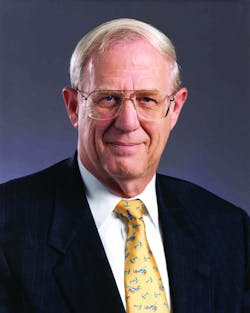In light of the publication's 25-year anniversary, Airport Business canvassed several airports to get perspective on how the industry has changed over the years, and what the future may look like. Commenting on the topic are James Wilding, former president and CEO, Metropolitan Washington Airports Authority; Rosemary Vassiliadis, deputy director of aviation, McCarran International Airport; Raul Regalado, president and CEO, Metropolitan Nashville Airports Authority; and Stephanie Gehman, marketing manager, Harrisburg International Airport.
"Aviation has changed dramatically - and the airport business, if anything, has changed more dramatically than the rest of the industry," comments Wilding.
A civil engineer by education, Wilding worked on the project to build Dulles International as a junior engineer in 1959; he eventually became head of Washington National and Dulles in '79, and continued until his retirement in 2003. All in all, he worked more than 44 years in the aiport business.
"A couple things have changed that have had the net effect of putting airports in much greater control of the business than was the case years ago," says Wilding.
"First, it’s important to realize that particularly in the pre-deregulation era, the movement of airlines into and out of airports was glacial … you could work for an airport for twenty years and only see one or two new airlines providing service. Post-deregulation, where the barriers to carrier entry and exit were first lowered and then eliminated, airlines came and went faster than you could count them.
"As an airport, you had to assemble yourself into a business unit; that’s were air service marketing moved into the forefront from an airport operator’s perspective - you really needed to understand your market and make a cogent argument to the financial community.
"I think it snowballed to the point where airport operators are themselves very large businesses today with multi-billion dollar balance sheets; 20-25 years ago, that just not only didn’t exist, I don’t think anybody really saw that it was going to exist."
Regalado also has more than 44 years of experience in aviation. Prior to joining the Nashville Airport Authority, Raul served as president of Raul Regalado & Associates; before that, he served as deputy director of aviation for the City of Houston.
"The relationship with the airlines has changed significantly; it used to be a more cordial relationship," says Regalado. "Non-aeronautical revenues are key today; we try to generate as much as we can to keep our rates down."
9/11 and security
Vassiliadis Started at McCarran in 1997 with a background in finance. "Talk about a profound experience, I closed an airport on 9/11; with that event, security became a dominant force in airport operations," she remarks. "We look at everything we do differently now; everything has a security aspect that needs to be addressed.
"We were one of the first airports to put in an in-line screening node; ours was 100 percent operational in 2005. We started immediately because of the type of airport we are, and the space constraints we are faced with here. The construction of the in-line baggage screening was our number one priority; to get it implemented and behind the wall – the new normal for check-in operations."
At 9/11, McCarran had 12 security checkpoints, and now it has 44, she relates.
Says Wilding, "I don’t think anybody was really comfortable with the airline-provided security contractors that existed before 9/11. Then came this huge political upsurge by the government which led to the creation of TSA. I think the industry went from one extreme to another without pausing in the middle.
"There was a missed opportunity to have airport operators move into that line of work; they already had substantial law enforcement responsibilities and many had their own police departments.
"Literally within a matter of days, it was accepted that there would be some Federal entity formed to take over airport security … there really wasn’t any debate about it. That created an agency that in its initial form looked way too much like a law enforcement agency. You then got into this realm where TSA was able to dictate space requirements and needs without any counterbalancing forces of how much in the way they were getting.
"It led to several years where there was a lot of hostility toward TSA at many airports … over the years it’s settled into a much more workable arrangement today."
Airport security in and of itself has impacted the passenger processing through the terminals significantly, explains Regalado. "We have changed our security checkpoint area dramatically from what it was six or seven years ago. The building was constructed over 20 years ago, so the type of security screening we have now was never anticipated; we had to create a centralized security checkpoint.
"Even the current terminal design [only three years old] has had to be changed to accommodate the full-body scanners. I’m sure there will be some additional equipment that comes out in the next couple years that will have to be shoehorned into this area."
Technology
"Our investment in technology is something that is absolutely necessary because we’ve been a constrained facility for so long, and because we have the highest peaks of seat capacity and passengers in a two-three hour period," says Vassiliadis. "We had to rely on technology and it has been a key factor for us over the years.
"In the mid-‘90s, we were the first airport to implement common use terminal equipment (CUTE). Everywhere in our terminal and gate area, from check-in kiosks to gate utilization, any airline can power up. There is not a proprietary airline computer here; everything is common use. It helps our flexibility with those peaks in passengers that we have here."
From the customer relations side of the business, Gehman at Harrisburg says her goal in accepting the position five years ago was to put the airport more into the digital sphere; her first major project was an overhaul of the company website in 2006. With the advent of the Internet, and now with Web-based applications, airports have a myriad of tools to use for relating information to the customer base.
"The evolution of content on a website is important; it can change on a weekly basis," says Gehman. "From a search engine optimization standpoint, obviously making sure the content is rich and being sure the website is indexed properly … that’s always something that needs to be updated. On the front-end, the travelers’ needs are always changing, so the information needs to change as well."
In terms of partnering with carriers, Gehman says of late, the airport has done a lot with American Eagle. "We’ve made it clear to our airline partners that if they have any message, whether traditional or emerging, we will do our utmost to get it out."
"We’ve also been using Foursquare for more than a year now; we’ve done manager specials and check-in specials.
"I think it really comes down to further personalizing the experience for the traveler across the board ... where the Web becomes more of a personal assistant for the user, or in our case, the traveler."
About the Author

